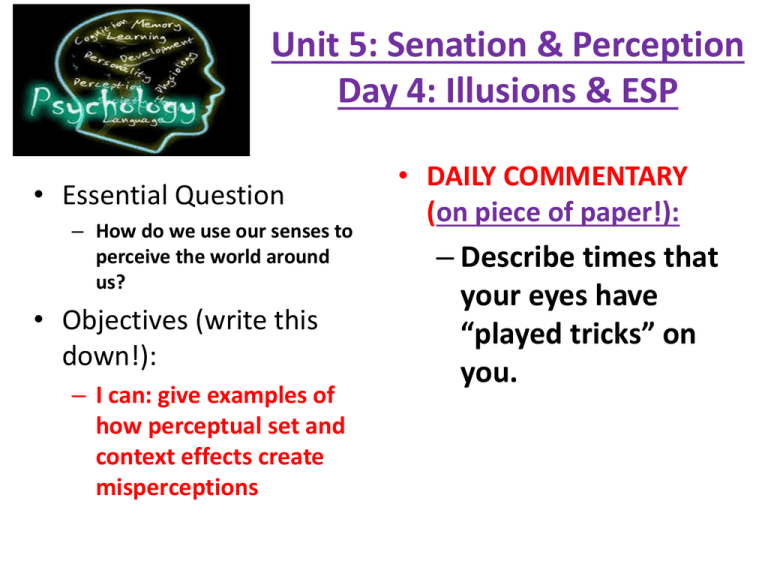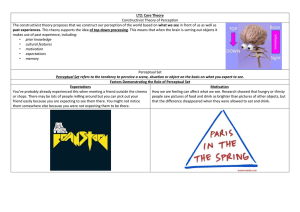Perception & binocular cues
advertisement

Unit 5: Senation & Perception Day 4: Illusions & ESP • Essential Question – How do we use our senses to perceive the world around us? • Objectives (write this down!): – I can: give examples of how perceptual set and context effects create misperceptions • DAILY COMMENTARY (on piece of paper!): – Describe times that your eyes have “played tricks” on you. Unit 5: Senation & Perception Day 4: Illusions & ESP • Essential Question – How do we use our senses to perceive the world around us? • Objectives (write this down!): – I can: give examples of how perceptual set and context effects create misperceptions • DAILY COMMENTARY (on piece of paper!): – Write a 1 sentence factual statement about yourself. • For example: I was born in June and love pizza. – Then fold it up and put it in the box. Unit 5: Senation & Perception Day 4: Illusions & ESP • Today: – – – – – DC ESP Notes PsychSym5 Module Discussion of Interview Project • SUBMIT: – Missing work you have completed • For Tonight: – Minority Studies Take Home Exam Perceptual Adaptation Courtesy of Hubert Dolezal Visual ability to adjust to an artificially displaced visual field, e.g., prism glasses. 4 Perceptual Set A mental predisposition to perceive one thing and not another. What you see in the center picture is influenced by flanking pictures. From Shepard, 1990. 5 Perceptual Set Other examples of perceptual set. Dick Ruhl Frank Searle, photo Adams/ Corbis-Sygma (a) Loch ness monster or a tree trunk; (b) Flying saucers or clouds? 6 Schemas Schemas are concepts that organize and interpret unfamiliar information. Courtesy of Anna Elizabeth Voskuil Children's schemas represent reality as well as their abilities to represent what they see. 7 Selective Attention Perceptions about objects change from moment to moment. We can perceive different forms of the Necker cube; however, we can only pay attention to one aspect of the object at a time. Necker Cube 8 Perceptual Illusions Illusions provide good examples in understanding how perception is organized. Studying faulty perception is as important as studying other perceptual phenomena. Line AB is longer than line BC. 9 Tall Arch Rick Friedman/ Black Star In this picture, the vertical dimension of the arch looks longer than the horizontal dimension. However, both are equal. 10 Illusion of a Worm © 1981, by permission of Christoph Redies and Lothar Spillmann and Pion Limited, London The figure on the right gives the illusion of a blue hazy “worm” when it is nothing else but blue lines identical to the figure on the left. 11 3-D Illusion Reprinted with kind permission of Elsevier Science-NL. Adapted from Hoffman, D. & Richards, W. Parts of recognition. Cognition, 63, 29-78 It takes a great deal of effort to perceive this figure in two dimensions. 12 Perceptual Organization When vision competes with our other senses, vision usually wins – a phenomena called visual capture. How do we form meaningful perceptions from sensory information? We organize it. Gestalt psychologists showed that a figure formed a “whole” different than its surroundings. 13 Form Perception Organization of the visual field into objects (figures) that stand out from their surroundings (ground). Time Savings Suggestion, © 2003 Roger Sheperd. 14 Features on a Face Face schemas are accentuated by specific features on the face. Kieran Lee/ FaceLab, Department of Psychology, University of Western Australia Students recognized a caricature of Arnold Schwarzenegger faster than his actual photo. 15 Eye & Mouth Eyes and mouth play a dominant role in face recognition. Courtesy of Christopher Tyler 16 Context Effects Context can radically alter perception. Is the “magician cabinet” on the floor or hanging from the ceiling? 17 Cultural Context Context instilled by culture also alters perception. To an East African, the woman sitting is balancing a metal box on her head, while the family is sitting under a tree. 18 Apparent Motion Phi Phenomenon: When lights flash at a certain speed they tend to present illusions of motion. Neon signs use this principle to create motion perception. Two lights one after the Illusion other. of motion. One light jumping from flashing one point to another: 19 Perceptual Constancy Perceiving objects as unchanging even as illumination and retinal images change. Perceptual constancies include constancies of shape and size. Shape Constancy 20 Size Constancy Stable size perception amid changing size of the stimuli. Size Constancy 21 Size-Distance Relationship The distant monster (below, left) and the top red bar (below, right) appear bigger because of distance cues. Alan Choisnet/ The Image Bank From Shepard, 1990 22 Ames Room The Ames room is designed to demonstrate the sizedistance illusion. 23 Lightness Constancy The color and brightness of square A and B are the same. 24 Color Constancy Perceiving familiar objects as having consistent color even when changing illumination filters the light reflected by the object. Color Constancy 25 Perception Revisited Is perception innate or acquired? 26 Free Response Prompt • John and Susan were watching a movie late at night in a dimly lit room when suddenly John became startled. He stopped the film and asked if Susan had also seen something red run across the floor. Susan yawned, roused herself, and responded that she thought she saw something move, but did not see any colors and could not tell what it was. After turning on the light, they discovered that their little sister had rolled a red ball across the floor from the other room. • Explain how each of the following would likely have affected the different sensory inputs that John and Susan encoded: rods cones absolute threshold Signal Detection Theory Lens Transduction Optic nerve Foveal vision • • • • • • • • Is There Extrasensory Perception? Perception without sensory input is called extrasensory perception (ESP). A large percentage of scientists do not believe in ESP. 28 Claims of ESP Paranormal phenomena include astrological predictions, psychic healing, communication with the dead, and out-of-body experiences, but most relevant are telepathy, clairvoyance, and precognition. 29 Claims of ESP 1. Telepathy: Mind-to-mind communication. One person sending thoughts and the other receiving them. 2. Clairvoyance: Perception of remote events, such as sensing a friend’s house on fire. 3. Precognition: Perceiving future events, such as a political leader’s death. 30 Premonitions or Pretensions? Can psychics see the future? Can psychics aid police in identifying locations of dead bodies? What about psychic predictions of the famous Nostradamus? The answers to these questions are NO! Nostradamus’ predictions are “retrofitted” to events that took place after his predictions. 31 Putting ESP to Experimental Test In an experiment with 28,000 individuals, Wiseman attempted to prove whether or not one can psychically influence or predict a coin toss. People were able to correctly influence or predict a coin toss 49.8% of the time. 32 PsychSym5 • Sensation & Perception – Perceptual Illusions






